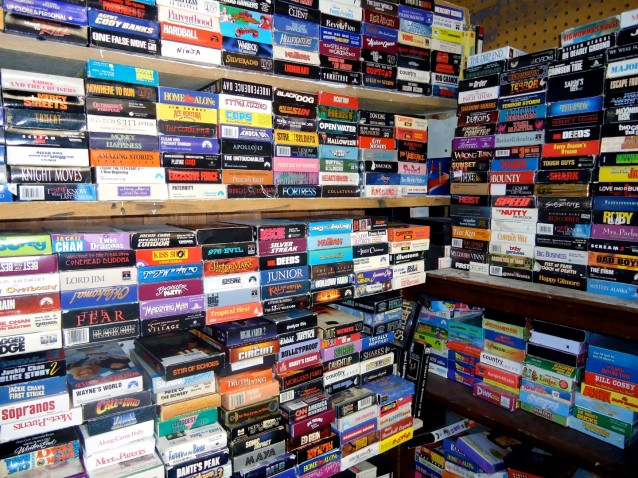In 2023, we don’t often find ourselves using physical media to watch television shows or to listen to music, all of that stuff has moved into the cloud thanks to innovations in internet speeds. This makes the change in culture just ten years ago a shock, as 2013 was still a point in time where DVDs were still a common sight in households.
The death of physical media has been felt across every facet of the entertainment industry, with most companies refusing to look back. At the staggering costs of producing and distributing them at the much simpler and cheaper option to make it available online to stream. This shift isn’t very surprising, since that’s just the way technology works.
While the logistics associated with DVDs was staggering for sure, it could have been and was much worse at one point with VHS, a video format developed by JVC in 1976 that used magnetic tape to store video data. The technology behind it was innovative for its time, however diving further into VHS reveals the plethora of issues that make me question why we ever stuck with it.
The World Before VHS Began
The Video Home System was never designed as a revolutionary tool for home video… or video in general. The concept of magnetic tape to store video was experimented with as early as the 1950s, and formats like U-Matic had made design choices reminiscent of VHS as early as 1971. VHS was not even the first format to do what it was intended for nor what it would evolve into, as Sony beat them to the market with Betamax in 1975. The competition between these two formats would be a staple “format war” for the 1980’s being as iconic as Coke vs Pepsi.
Film is also a large consideration into this, even though it sort of ran in a league of its own given the more complex setup it had. Unlike digital media, film was very much physical and demanded a large and complex set up to shine light through one frame of a film strip, rack the next frame up, and do it again 23 other times every second. Consumerism in itself is based on appealing to a product’s convenience, which was something film could not easily do.
The Format Wars
VHS releasing to the market would begin a power struggle between JVC and Sony, knowing whoever won their war would benefit greatly in the long run.
Betamax had a couple of things up its sleeve, such as:
- Compact Size
- Construction Quality
- Picture Quality
Betamax’s extra 10 lines of horizontal resolution would give it an edge in marketing, making it the superior format for cleaner and more accurate picture quality. However Sony would underestimate the VHS format, because many aspects of VHS that made it the rougher format would inevitably make it more appealing in the consumer space.
VHS would show up it’s competitor with:
- Cheaper manufacturing costs
- Cheaper retail prices
- Longer storage capacity
VHS and Betamax were originally advertised to be like a modern day DVR, so storage capacity was a big seller. Alongside its price, VHS would soon beat out Betamax as the superior format for the avid television watcher on a budget.
The VHS We Know And Love
During its relevance, VHS was the dominant video format for almost everything. If you wanted to record a show for later, VHS was your go to. Later in its life movies and tv shows would begin being mastered onto tapes from the factory and sold to the consumer much like how DVDs work today, except their prices were hiked to an exorbitant limit due to publishing companies trying to make up the difference in recurring ticket costs at the theater.
This pricing would birth the famous video store, further cementing the zeitgeist that was video tape into public culture for years. Eventually the price went down thanks to Top Gun’s home video release, which would birth home video collections. For Christmas, an exorbitant gift was a VCR. VHS was everywhere, it ruled the world and made you know it did.
Tapes were pushed to their limits, manufacturing got even cheaper and simpler. This birthed lower prices and easier accessibility. Long Play and Extended Long Play modes were introduced to get a staggering eight hours of video on a single cassette tape, where the normal time was two. At some point, everyone had them and used them everyday.
The Gunk of VHS
As the years went on with VHS, its issues would become enhanced with the marching of time. Even when it came out VHS was still a barbaric format that could only barely recreate a decent image. Over time, the tape would degrade and lose resolution with every time you recorded or played back something. Not to mention CRTs were being perfected, alongside digital displays that could deliver an image crisper than any CRT ever could.
While optional, the previously mentioned LP and EP modes on a VCR butchered the quality of a tape to fit the claimed 8 hours into one. With the cheaper manufacturing of VCRs and tapes also came an even further loss in quality. Working with this tape in any capacity began to turn into a clunky, sketchy, and low quality way to work with video.
VHS Finally Dies, Along With Its Legacy
The Compact Disc had existed alongside VHS since its heyday of the 1980s, being a completely digital format that gave a lossless means to store and read data. The only reason they didn’t surpass VHS was because it was an audio only format. Attempts would be made to bring the CD up to snuff, but be left by the wayside since the CD’s storage capacity was too abysmally small.
This would change however in 1996 when the Digital Versatile Disc hit the market, having the storage capacity to fit more than 15 minutes of video onto it. Pretty soon DVDs, along with the accompanying appliances would hit the shelves with movies and tv shows on them to give the consumer cheap and clean video. VHS would quickly become obsolete, with many people trashing their old tape collections or leaving them in their attic for the rest of their days to collect dust.
In the modern day, VHS is completely irrelevant. This isn’t much of a surprise to anyone, however the entire format had left its mark on multiple generations of people. It defined the 80s and 90s, being known as their token video format. Every piece of 1980s graphic design or clipart you see today incorporates the callsigns of VHS, and the common trope for an “old boomer” is to reference the days when tape was used instead of those new fangled phone devices.
If any collectors are looking to start their very own retro collection, tapes can be found online and in thrift stores at a staggering $1. I would compare VHS to the early days of unionization during the industrial revolution. It was woefully underpowered, but was better than nothing. VHS entered a vacant market, giving the consumer an introduction into home video. In the end, the downsides of VHS could be overlooked.
It’s beloved by many, with fond memories of slamming a tape into a machine to watch a movie. That experience is something future generations won’t really get to experience. And now with the consistent loss of interest in DVDs and its predecessor Blu-Ray, it’s almost sad to see the industry die out that was started with VHS. Many came before it trying to do the same, but VHS got it right. And for that, I will give it a small acknowledgement. Nothing more though, because it’s still an absolutely wretched platform.


 by
by 

